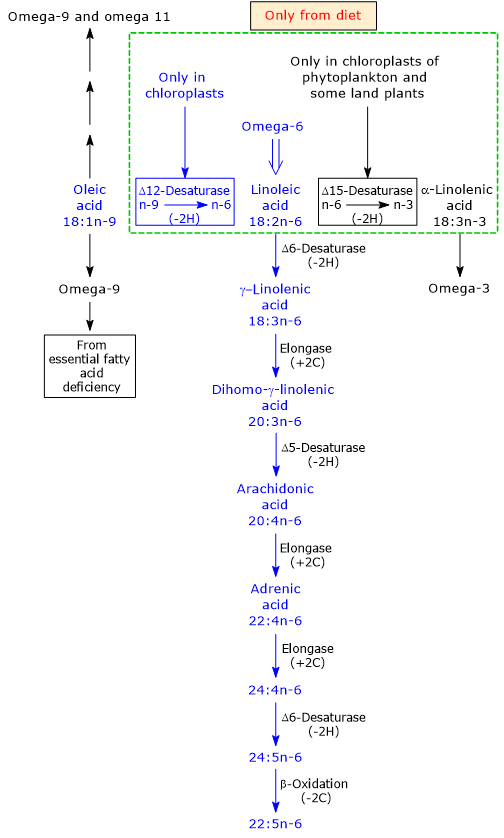Omega-6 polyunsaturated fatty acids are the major polyunsaturated fatty acids or PUFA in the Western diet (about 90% of all of them in the diet), being components of most animal and vegetable fats.
Contents
Synthesis
Within the omega-6 family, linoleic acid is one of the most important and widespread fatty acids and the precursor of all omega-6 polyunsaturated fatty acids. It is produced de novo from oleic acid, an omega-9 fatty acid, only by plant in a reaction catalyzed by Δ12-desaturase, i.e. the enzyme that forms the omega-6 polyunsaturated fatty acid family from omega-9 one.
Δ12-desaturase catalyzes the insertion of the double bond between carbon atoms 6 and 7, numbered from the methyl end of the molecule.
Linoleic acid, together with alpha-linolenic acid, is a primary product of plant polyunsaturated fatty acids synthesis.

Animals, lacking Δ12-desaturase, can’t synthesize it, and all the omega-6 polyunsaturated fatty acid family de novo, and they are obliged to obtain it from plant foodstuff and/or from animals that eat them; for this reason omega-6 polyunsaturated fatty acid are considered essential fatty acids, so called EFA. The essentiality of omega-6 polyunsaturated fatty acids, in particular just the essentiality of linoleic acid, was first reported in 1929 by Burr and Burr.
Omega-6 PUFA: from linoleic acid to arachidonic acid
Animals are able to elongate and desaturase dietary linoleic acid in a cascade of reactions to form very omega-6 polyunsaturated fatty acids.
Linoleic acid is first desaturated to gamma-linolenic acid, another important omega-6 fatty acid with significant physiologic effects, in the reaction catalyzed by Δ6-desaturase. It is thought that the rate of this reaction is limiting in certain conditions like in the elderly, under certain disease states and in premature infants; for this reason, and because it is found in relatively small amounts in the diet, few oils containing it, such as black currant, evening primrose, and borage oils, have attracted attention.
In turn gamma-linolenic acid may be elongated to dihomo-gamma-linolenic acid by an elongase. The enzyme catalyzes the addition of two carbon atoms from glucose metabolism to lengthen the fatty acid chain that may be further desaturated in a very limited amount to arachidonic acid, in a reaction catalyzed by another rate limiting enzyme, Δ5-desaturase.
Arachidonic acid can be elongated and desaturated to adrenic acid.
It should be noted that polyunsaturated fatty acids in the omega-6 family, and in any other n-families, can be interconverted by enzymatic processes only within the same family, not among families.
C-20 polyunsaturated fatty acids belonging to omega-6 and omega-3 polyunsaturated fatty acids are the precursors of eicosanoids (prostaglandins, prostacyclin, thromboxanes, and leukotrienes), powerful, short-acting, local hormones.
While the deprivation of omega-3 polyunsaturated fatty acids causes dysfunction in a wide range of behavioral and physiological modalities, the omission in the diet of omega-6 polyunsaturated fatty acids results in manifest systemic dysfunction.
In plant seed oils omega-6 fatty acids with chain length longer than 18 carbons are present only in trace while arachidonic acid is found in all animal tissues and animal-based food products.
References
- Akoh C.C. and Min D.B. “Food lipids: chemistry, nutrition, and biotechnology” 3th ed. 2008
- Aron H. Uber den Nahvert (On the nutritional value). Biochem Z. 1918;92:211–233 (German)
- Bender D.A. “Benders’ dictionary of nutrition and food technology”. 2006, 8th Edition. Woodhead Publishing. Oxford
- Bergstroem S., Danielsson H., Klenberg D. and Samuelsson B. The enzymatic conversion of essential fatty acids into prostaglandins. J Biol Chem 1964;239:PC4006-PC4008.
- Burr G.O. and Burr M.M. A new deficiency disease produced by the rigid exclusion of fat from the diet. Nutr Rev 1973;31(8):148-149. doi:10.1111/j.1753-4887.1973.tb06008.x
- Chow Ching K. “Fatty acids in foods and their health implication” 3th ed. 2008
- Rosenthal M.D., Glew R.H. Mediacal biochemistry. Human metabolism in health and disease. John Wiley & Sons, Inc. 2009
- Stipanuk M.H., Caudill M.A. Biochemical, physiological, and molecular aspects of human nutrition. 3rd Edition. Elsevier health sciences, 2012
- Van D., Beerthuis R.K., Nugteren D.H. and Vonkeman H. Enzymatic conversion of all-cis-polyunsaturated fatty acids into prostaglandins. Nature 1964;203:839-841